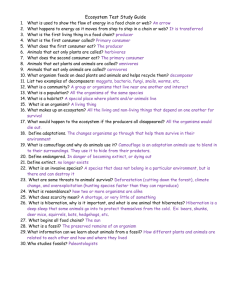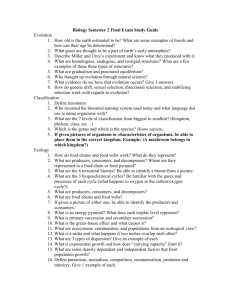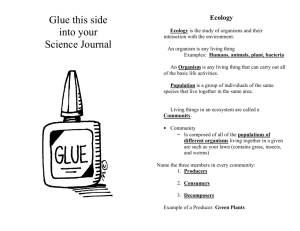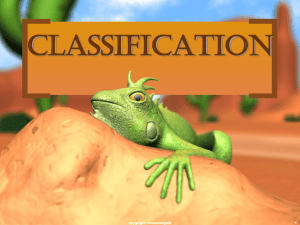Ecosystems
advertisement
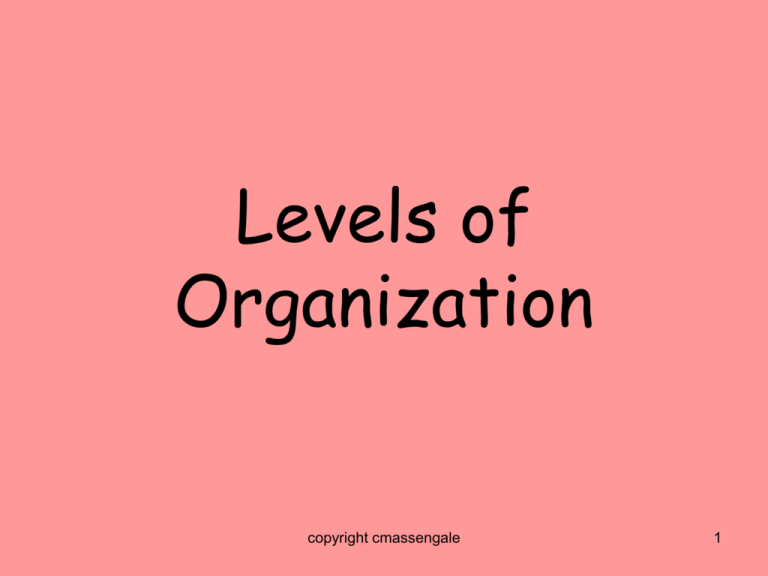
Levels of Organization copyright cmassengale 1 BrainPOP • http://www.brainpop.com/science/matteran dchemistry/bodychemistry/ • What does this have to do with ecosystems? – Ecology • The study of the interactions of organisms with one another and with their physical environments copyright cmassengale 2 Levels of Organization • Ecologists have organized the interactions an organism takes part in into different levels according to complexity. copyright cmassengale 3 What are the Simplest Levels? 1. 2. 3. 4. 5. 6. 7. Atom Molecule Cell Tissue Organ Organ System Organism 4 5 7th Level of Organization • Organism: An individual living thing that is made of cells, uses energy, reproduces, responds, grows, and develops 6 8th Level of Organization • Population: A group of organisms, all of the same species, which interbreed and live in the same place at the same time. copyright cmassengale 7 9th Level of Organization • Biological Community: All the populations of different species that live in the same place at the same time. copyright cmassengale 8 10th Level of Organization • Ecosystem: Populations of plants and animals that interact with each other in a given area with the abiotic components of that area. (terrestrial or aquatic) copyright cmassengale 9 11th Level of Organization • Biosphere: The portion of Earth that supports life. copyright cmassengale 10 What level of organization? copyright cmassengale 11 What level of Organization? 12 What level of Organization? copyright cmassengale 13 What level of Organization? 14 Ecosystems Ecosystem: a community of organisms and their environment (living and nonliving) Abiotic – non living Biotic – living or once alive Ecosystems contain many diverse organisms. Biodiversity – the variety and number of organisms in a given area. Biodiversity in a Rainforest Producers and Consumers Producer – (Autotrophs) capture energy from the sun or inorganic sources and make energy-storing molecules. -Plants, algae, and some bacteria and protists Consumer – (Heterotrophs) an organism that consumes other organisms to obtain energy. - Animals and some bacteria and protists Producers (AUTOTROPH) Plants Algae Bacteria Consumers (HETEROTROPHS) Herbivore: eats plants. These are primary consumers. Carnivore: • eats primarily meat. • Secondary and tertiary consumers Omnivore: eats both plants and meat. Decomposer: • break down dead organisms causing them to rot.. Decomposers • Feed on dead organisms • Decomposers feed on all levels: producers, primary consumers, secondary consumers, and tertiary consumer • The energy is taken by the producers Role of Decomposers • Energy is lost through heat and cell respiration (ATP production) • Decomposers consume dead • Decomposers put nutrients back into the soil for producers Detritivores: • help recycle dead matter on the planet; (decomposers and scavengers) Energy Flow in an Ecosystem • Almost all energy originates from the sun. • Energy flows through the trophic levels and between organisms and their physical environment. Photosynthesis • process in which light energy is converted into organic compounds. Cellular Respiration: • metabolic process that uses energy in food to make ATP Food chain: • route for the transfer of matter and energy (food) through an ecosystem. Food Web: • ALL the possible feeding relationships in a community. • There are several food chains in a food web: ~ Grass mouse owl ~ Grass mouse snake fox Energy Flow Pyramid • Producers: organisms that produce energy • Primary Consumers: those that consume producers • Secondary Consumers: organisms that consume primary consumers • Tertiary Consumers: organisms that consume secondary consumers Tertiary Consumers Secondary Consumers Primary Consumers Producers Energy Pyramids - Each trophic level is a block - Size of block = amount of energy. Only 10% of the energy goes from one level to the next Examples of Pyramids Tertiary Consumers Secondary Consumers Primary Consumers Producers Amount needed for carnivores Amount needed for herbivores BioGEOchemical Cycles • Nutrients cycle between organic and inorganic compartments – They cycle among organisms the physical environment. • Water Cycle – Global-driven by solar winds • Nitrogen Cycle – mostly by organisms in soil and water • Carbon Cycle– Photosynthesis Cellular Respiration • Phosphorous Cycle – Cycles locally in the ground The Water Cycle: • Water has the greatest influence out of all the nonliving components of an ecosystem. The Carbon Cycle: Carbon cycles between living and nonliving things in the environment. The Nitrogen Cycle: The nitrogen cycle is complex and has several stages: 1.Assimilation 2.Ammonification 3.Nitrification 4.Denitrification N2 Makes up 80% Atmosphere! Organisms need nitrogen and phosphorus to build proteins and nucleic acids. The Phosphorus Cycle: • Phosphorus is an important component in ATP and DNA. • Phosphorus dissolves in water and then absorbed by the roots of plants. Nonrenewable Resources - those that either take a very long time to replace or cannot be replaced at all (coal and oil) Copyright Cmassengale Resource Use • Renewable Resources - natural resources that can be replaced in a relatively short amount of time (sun, wind, rain …) Copyright Cmassengale BIOMES Major Biological communities that occur over a large area of land/water. Climate and biomes • The typical weather patterns over a long period of time is the climate. Biomes are a group of ecosystems with similar climates (temperature and rainfall) and organisms. Copyright Cmassengale Biomes of the world 1. 2. 3. 4. 5. 6. Rainforest Grassland Savannah Deciduous Forest Coniferous Forest Temperate Rain Forest 7. Desert 8. Tundra 9. Taiga 10. Freshwater Biomes: Lakes, ponds, streams, rivers 11. Marine Biomes 12. Estuaries • Climate effects where species live. - Temperature: organisms are adapted to live in a certain range of temperatures - Moisture: all organisms require water. What Biome is this? What Biome is this? What Biome is this? What Biome is this? Aquatic Biomes Adaptations • Each organism had to evolve for different biomes: – Physiologically (metabolism, homeostasis) – Anatomically (claws, scales, teeth) – Behaviorally (courtship, calls, migratory) copyright cmassengale 51 Ecological succession Primary succession – in an area of newly exposed land that has NEVER been occupied by a living (biotic) community. Secondary succession - takes place where a community has been removed (cut forest, forest fire) • r-strategists: disturbed or transitionary habitats are typically populated by rapidly growing species. (r-strategists). Seeds (preennials, grasses, wildflowers) are usually the first to colonize a habitat. r-strategists: short life spans, short generation times, large numbers of offspring, have efficient means of dispersal. Given time other slower growing organisms will follow. • K-strategists When a habitat is populated with a diverse collection of organisms competing with one another the advantage shifts K-strategists. The species will benefit most by a close adaptation to the conditions of its environment. K-strategists : found in stable habitats, long life span, long generation time, small numbers of offspring, take care of their young. http://www.prism.gatech.edu/~gh19/b1510/comeco1.htm http://www.biologycorner.com/worksheets/examining_stages_successi on.html Limiting Factor: • A single factor that limits the growth, abundance, or distribution of a population. – Ex: Humans, natural occurrences, and predators • Density Dependent- the denser the populations, the more slowly it grows • Density Independent- population growth is limited by factors other than population density – Fire, drought and natural disasters Carrying Capacity • the maximum number of individuals a habitat can support Ecosystem stability • How does the oil spill, radiation leaks, green house effect, deforestation or the growth in El Paso affect ecosystem stability? II. How Organisms Interact Habitat & Niche • Habitat is the place a plant or animal lives • Niche is an organism’s total way of life NICHE HABITAT COMMUNITY 59 Competition • Each organism has it’s own niche, when two species use the same resource they are competing for that resource. Competition influences the makeup of communities. Predation • One organism is killing another for food. Symbiosis Living Together Types of Symbiosis • Mutualism • both species benefit • Commensalism • one species benefits, the other is unaffected • Predation • one species benefits, the other is killed Types of Symbiosis • Parasitism • one species benefits, the other is harmed • Competition • Two or more organisms seek the same resource at the same time and they fight for the food/living space/and other resources they need to survive Mutualism • Both organisms benefit from the relationship Otters and Kelp The otters help the kelp by eating the sea urchins which endanger it. The kelp provides an anchor for the otters while they sleep. Lichen • Lichen is really two organisms: algae and fungus. The fungus needs food but cannot make it. The algae makes food but needs some way to keep moist. The fungus forms a crust around the algae which holds in moisture. Both organisms benefit. The Chital and the Treepie• The tree-pies help the chital by stripping the dead velvet from the antlers. This provides them with nourishment Therefore both species are benefiting from this symbiotic behavior. Cleaner Fish and the Moray Eel • The cleaner fish eats parasites and food bits out of the inside of this moray eel. It gets a meal and is protected from predators by the fierce eel. Yucca Plants and Yucca Moths • Each type of Yucca plant can only be pollinated by a specific kind of Yucca moth. • That moth can only live on that kind of Yucca. Swollen Thorn Acacia Tree and Ants • The tree provides a nursery for the ants in the thorns and makes special food for the ant babies. • In return the ants sting and attack any other plants or insects that try to invade the tree. Commensalism • One species benefits while the other is uneffected The cattle egret and cows The cattle help the egret who look for grasshoppers and beetles that are raised by the cows. Now and then they sit on the back of a cow, looking for ticks and flies. This does not effect the cattle in any way. Barnacles and Whales • Barnacles need a place to anchor. They must wait for food to come their way. Some barnacles hitch a ride on unsuspecting whales who deliver them to a food source. This does not effect the whale in any way. Oak Gall Wasps and Oak Trees • The oak gall wasp stings the oak tree. • the tree then grows a GALL which is a nest for the wasp’s babies. • When the larva hatch, they eat their way out of the gall. • Does not help or hurt the oak tree Parasitism • One species benefits while the other is harmed Mistletoe is an aerial parasite that has no roots of its own and lives off the tree that it attaches itself to. Without the tree it would die. It slowly chokes out the life of the host tree. Bedbugs • Bedbugs are small, nocturnal parasites that come out of hiding at night to feed on unsuspecting humans. They feed exclusively on blood! Their bites often result in an allergic reaction. Tapeworms • The definitive host of the cucumber tapeworm is a dog or a cat (occasionally a human). Fleas and lice are the intermediate host. the dog or cat becomes contaminated when the eggs are passed in the feces, and the flea or louse ingests the eggs. The dog or cat (or human) is infected when they ingest a flea or louse. Hence the importance Which type of symbiosis is it? • Mutualism, commensalism, parasitism Fleas/dogs Lice/humans Clownfish/sea anemone Crocodile bird/crocodile Joshua tree/pronuba moth VIDEO ACTIVITY • Overview Video • You will watch the videos about ecological relationships. • You will predict which relationship is being depicted. • Finally, you will confirm which relationship was demonstrated. Organismal Behaviors 1. Fight or Flight copyright cmassengale 78 Organismal Behaviors 2. Territorial Displays copyright cmassengale 79 Organismal Behaviors 3. Circadian Rhythms copyright cmassengale 80





